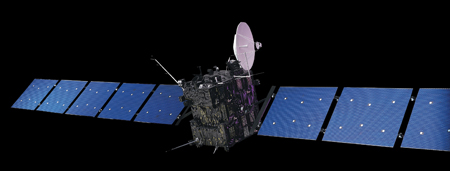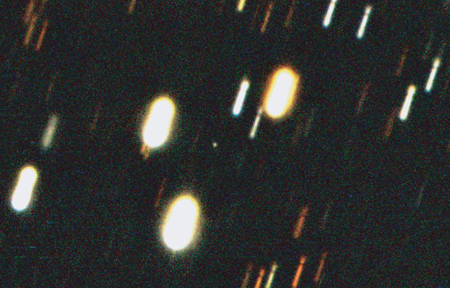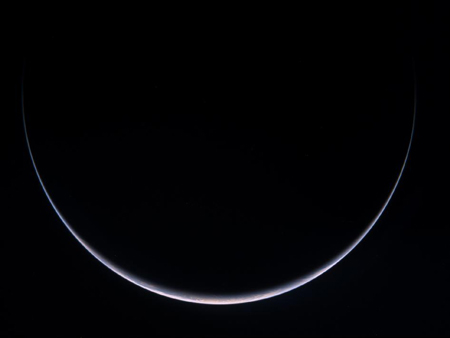« another one, what connects these words... | Main | latest list of connections »
March 27, 2009
Meanwhile out in the far-flung regions of deep space
In March 2004, from a launch site in French Guiana, on board an Ariane 5G rocket, the European Space Agency hurled a spacecraft into – well – space [which, if we’re honest, is as good a place as any to hurl a spacecraft]. There to start it’s 12 year mission to boldly go where no spacecraft has gone before, to explore strange new civilisations comets, and generally find out everything it can about a lump of dirty ice whizzing about the Universe.

Spacecraft Rosetta, Photo: ESA.
Rosetta*, for this is the name of the spacecraft, is chasing a comet. The sort of thing our ancestors could only dream about. And not just any passing comet, but comet 67/P. Or, as it’s more properly known: comet 67/P Churyumov-Gerasimenko**.

Comet 67/ P Churyumov-Gerasimenko [the white dot in the middle]
Now why are the ESA spending umpty-millions flinging a few low-gas spectrometers, sub-surface probes and residual dust monitors into deep space? Well apparently this will give us the low-down on how the universe came into existence. Comets, we are led to believe, are the last remnants of the first few chaotic moments of this celestial palace we’re currently camping in.
Rosetta is, as I type, whipping itself around twixt Mars and Earth in a series of romantic gravity-assisted manoeuvres with a view to gaining enough momentum to sling-shot itself out into deep space to meet up, 4 years later, with comet 67P, some 1000 million kilometres from Earth. When it’s there [1000,000,000 kilometres away] it will brake, to slow down, then reverse into position next to the comet – this is parallel parking on a Galactic scale.

The Optical Spectroscopic and Infrared Remote Imaging System (OSIRIS) camera on board Rosetta observed Earth during its swing-by last November. Photo: ESA.

Earth - detail. Photo: ESA.
Find out more about Rosetta here
*named after the Rosetta Stone, a stone found near Rosetta in Egypt, in 1799. You see how it all comes together? This stone had an inscription carved on it in two languages. One was Greek the other was Egyptian hieroglyphics. So we were able to do a Dan Brown and crack the code of the Pharaohs’ hippy writing.
** In 1969 Klim Ivanovich Churyumov was looking at a picture taken by Svetlana Gerasimenko of comet 32/P and he noticed another cometary object in the corner of the photograph. As this was the sixty-seventh such cometary object to be discovered, it received that number, and as it was determined to be periodic, it received the suffix P. Such is the heady stuff of cometary nomenclature.
Posted by john at March 27, 2009 09:37 AM
Comments
Wow! Knowledge with my porridge this morning, all right. It must take quite a long time with a pencil, ruler and slide rule to work out how to parallel park a spacecraft next to a comet. Perhaps one day I'll learn how to do it in a car.
Posted by: Daphne at March 28, 2009 10:44 AM